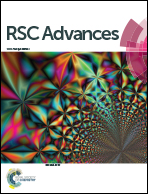Preparation of mechanically stable triple-layer interference broadband antireflective coatings with self-cleaning property by sol–gel technique†
Abstract
Antireflective coatings usually suffer from poor functional durability during outdoor service. The incorporation of additional properties, such as broadband antireflection, self-cleaning and mechanical stability, is of great importance. In the current work, we synthesized broadband AR coatings via the design concept of triple-layer interference coating. SiO2–TiO2, TiO2 and nanoporous TiO2–SiO2 composite thin films were employed as bottom, middle and top layers. Substrates (BK-7 glass) coated with the triple-layer films attained consistent high transmittances at 500–700 nm and the average transmittance at that region was 99.4%. The triple-layer films exhibited an outstanding superhydrophilic property with water contact angle of 2° in 0.5 s, and the superhydrophilicity could last for 30 days in the absence of UV illumination. These triple-layer coatings also showed a good ability to decompose organic substances under UV irradiation. The synergistic effect between superhydrophilicity and photocatalysis provides the films with self-cleaning effect. Meanwhile, the abrasion resistance test of the triple-layer films indicated favorable robustness and good adhesion of the films to substrates. This multifunctional film can have potential applications in various areas, like solar cell panels, green houses and architectural glasses.



 Please wait while we load your content...
Please wait while we load your content...